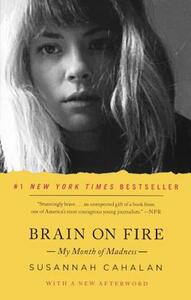You need to sign in or sign up before continuing.
Take a photo of a barcode or cover
Susannah Cahalan was 24 when the events of this book happened, a fact that has really shaken me to my core. Not to minimize the trauma of needing to rely on the memories of her family and friends and notes from doctors to fill in the gaps for this story, but it was an unusual outside perspective for a memoir that helped create a broader picture of what was happening both to Susannah and to the people around her.
4.5-5/5 stars. This is a book I’ve been meaning to tackle for a long time. My professional life intersects with the disease discussed in this book (I’m actually a coauthor on a manuscript with Dr. Dalmau), and learning about patient experiences is always humbling. I’m inspired by the author’s bravery around exposing her thoughts and recollections during her acute psychosis, and the challenges she faced fighting to get her sanity back. Would recommend to anyone working in the neuroscience field to learn about the struggles people we study face and why our work is so important. I would recommend to everyone else because it’s a beautiful story about being scared, losing independence, complicated family dynamics, and coming to terms with the both the limitations of our minds and our own mortality.
I enjoyed this book, however it wasn’t necessarily one that would keep me up all night reading. And I don’t think that’s what it was meant to be. I certainly am interested in reading more about Susannah’s diagnosis, and it made me consider undiagnosed cases in many mental illnesses or neurological disorders. It’s definitely interesting to hear a person’s perspective of psychosis.
Imagine knowing that you are embarking on a downward spiral but being powerless to stop it. Sounds horrifying, right? It is, and it’s exactly what happened to Susannah Cahalan, a 24-year-old New York Post reporter. What began as a bite mark and a few overreactions quickly led to seizures, physical and mental deterioration, and to a troubling diagnosis. Was it because she drinking too much? Having a nervous breakdown? A psychotic break? Was she schizophrenic? Bipolar? With a full spectrum of symptoms that fit into a number of conditions and disorders, the Susannah friends and family knew and loved had disappeared.
Brain on Fire: My Month of Madness is the fascinating story of Cahalan’s journey to hell and back. Because she has no memory of her experience, she has reconstructed in her memoir her lost month by relying on videotapes, journals, and interviews with friends, family, and doctors. From paranoia, seizures, hospitalization, hallucinations, and short-term memory loss to the misdiagnoses and road to recovery, she holds nothing back. The result is an incredible story that is impossible to put down.
As brutal as this book is (which I happened to start on March 16, the day she entered the hospital in 2009), the fact that she was able to write it is an indication that it has a happy ending. It’s also clear that Cahalan is, by trade, a writer. Whether it’s her writing style or the story itself, I eagerly raced through the pages with awe and wonder at what she went through and where she ended up. She leaves no stone unturned, discussing how the experience changed her relationships with her previously distant father and new boyfriend and its impact on her job. She also chronicles her recovery, detailing awkward social exchanges, going back to work, and how the experience changed her life in ways she is still realizing. It’s a stunning story but it’s also a painful one, filled with terrible experiences she asserts she wouldn’t wish on her worst enemy.
For the full review, visit The Book Wheel.
Brain on Fire: My Month of Madness is the fascinating story of Cahalan’s journey to hell and back. Because she has no memory of her experience, she has reconstructed in her memoir her lost month by relying on videotapes, journals, and interviews with friends, family, and doctors. From paranoia, seizures, hospitalization, hallucinations, and short-term memory loss to the misdiagnoses and road to recovery, she holds nothing back. The result is an incredible story that is impossible to put down.
As brutal as this book is (which I happened to start on March 16, the day she entered the hospital in 2009), the fact that she was able to write it is an indication that it has a happy ending. It’s also clear that Cahalan is, by trade, a writer. Whether it’s her writing style or the story itself, I eagerly raced through the pages with awe and wonder at what she went through and where she ended up. She leaves no stone unturned, discussing how the experience changed her relationships with her previously distant father and new boyfriend and its impact on her job. She also chronicles her recovery, detailing awkward social exchanges, going back to work, and how the experience changed her life in ways she is still realizing. It’s a stunning story but it’s also a painful one, filled with terrible experiences she asserts she wouldn’t wish on her worst enemy.
For the full review, visit The Book Wheel.
emotional
hopeful
informative
emotional
informative
mysterious
reflective
fast-paced
emotional
hopeful
informative
medium-paced
informative
emotional
informative
reflective
medium-paced
As a zebra, I loved all of this. Great research, memoir and tie into future research and initiatives. This is the best way for change to occur. Thank you for this book!



